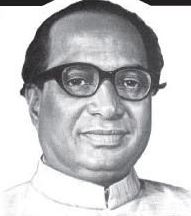
Vasantrao Banduji Patil was an Indian politician from Sangli, Maharashtra. He was known as the first modern Maratha strongman and first mass leader in Maharashtrian politics.

Dr. Babasaheb Ambedkar Marathwada University (BAMU), formerly Marathwada University, is located in Aurangabad, Maharashtra, India. It is named after B. R. Ambedkar, an Indian jurist and politician. The university was established on 23 August 1958. Since its inception, the university has around 456 colleges affiliated to it in four districts of Maharashtra State.

Babasaheb Anantrao Bhosale was an Indian lawyer and politician who served as Chief Minister of Maharashtra from January 1982 until February 1983.

Gulabrao Raghunathrao Patil was a Renowned Co-operative Leader, Member of Parliament (MP)-Rajya Sabha India, Maharashtra State Sangli from 1966 to 1978,Member of the Legislative Council (MLC) of Maharashtra 1983−87 and president of Maharashtra Pradesh Congress(I) Committee 1981−82. Patil also served as chairman of Maharashtra State Co-operative Bank in Mumbai from 1980 to 1982, chairman of Sangli District Cooperative Bank Sangli and Secretary of National Co-operative Union of India (NCUI), New Delhi. Gulabrao Patil was regarded as a Maratha Strongman in Maharashtra politics in the 1970s and 1980s. Year 2020–2021 is going to celebrate as Birth Centenary Year of Late. Gulabrao Patil (1921–2021)
Gangapur is one of the six constituencies of the Maharashtra Legislative Assembly, that are located in the Aurangabad district.
Tulsidas Jadhav was an Indian freedom fighter, political activist, social worker, farmer and member of Bombay Legislative Council and Lok Sabha.
Shahuwadi (Vidhan Sabha constituency) is one of the 288 Vidhan Sabha (legislative assembly) constituencies of Maharashtra state, western India. This constituency is located in Kolhapur district.
Sudhakarrao Naik was sworn in as Chief Minister of Maharashtra on 25 June 1991, on resignation of his predecessor Sharad Pawar. The ministry served until February 1993, when Naik resigned due to his inability to handle the 1993 Bombay riots, and was replaced by Pawar.
After securing a majority in the 1990 Maharashtra legislative elections, the incumbent Chief Minister Sharad Pawar was re-appointed on 4 March 1990. Pawar formed his third ministry, consisting of 15 cabinet ministers and 6 ministers of state. The cabinet continued until June 1991, when Pawar was replaced by Sudhakarrao Naik.
On resignation of Shankarrao Chavan on 26 June 1988, Sharad Pawar was appointed Chief Minister of Maharashtra for the second time. Pawar formed his second ministry, which continued in office until legislative elections in 1990.
Shankarrao Chavan was sworn in as Chief Minister of Maharashtra for the second time in March 1986, on resignation of his predecessor, Shivajirao Patil Nilangekar. Chavan's cabinet served until his resignation on 26 June 1988, and subsequent replacement by Sharad Pawar's ministry.
Shivajirao Patil Nilangekar became the chief minister of Maharashtra in June 1985, on resignation of Vasantdada Patil. He formed a 11-member ministry that served for less than a year until Nilangekar's resignation amidst fraud allegations.
After the Congress (I) party secured a majority in 1980 Maharashtra legislative elections, A. R. Antulay was appointed Chief Minister. Antulay's administration continued until January 1982, when he resigned amidst corruption allegations. Till date, Antulay remains the state's only Muslim chief minister.
After securing a majority in the 1985 Maharashtra legislative elections, the incumbent Chief Minister Vasantdada Patil was re-appointed on 10 March 1985. Patil formed his fourth and last ministry, consisting of 7 cabinet ministers besides him. The cabinet continued for about 3 months, as Patil resigned and was replaced by Shivajirao Patil Nilangekar in June 1985.
Babasaheb Bhosale was appointed as the Chief Minister of Maharashtra on resignation of A. R. Antulay in January 1982. Bhosale had been law, labour, and transport minister in Antulay's cabinet. Bhosale's government served for about a year, until he was replaced by Vasantdada Patil in February 1983.
In the aftermath of 1978 Maharashtra legislative elections, Vasantdada Patil of the Indian National Congress(U) was appointed Chief Minister. A coalition government, it consisted of members from Congress(Urs) and Congress (I), including Deputy Chief Minister Nashikrao Tirpude.
Vasantdada Patil became the Chief Minister of Maharashtra for the first time on 17 April 1977, replacing Shankarrao Chavan. The government continued until the 1978 legislative elections, after which Patil continued with his second ministry.
Shankarrao Chavan was appointed as Chief Minister of Maharashtra for the first time on 21 February 1975, replacing Vasantrao Naik. His first ministry lasted till 16 April 1977, and was succeeded by Vasantdada Patil's ministry.
Following 1972 Maharashtra Legislative Assembly election, incumbent chief minister Vasantrao Naik was re-appointed, and he formed his third government on 14 March 1972. This was to be Naik's last government which served until 20 February 1975.




